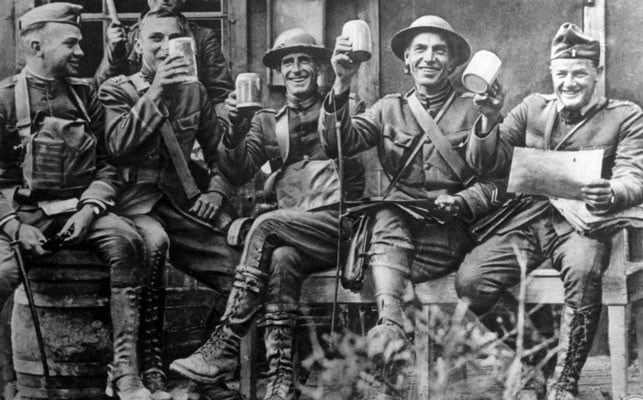If you've ever had the good luck of seeing a beautiful collection of historic German beer steins on display — an up-close-and-personal display with good lighting setting off the rich pewter thumblift and lid; the blues and golds in the faience glazes portraying wonderful stags and horses and birds; the comical people and animals featured in "character" steins (a woman masquerading, a drunk, a gentleman rabbit or silly-faced monkey, or even old Bismarck himself) — you'll know what I mean when I say they're works of art.
Besides the songs and poems and customs that have bubbled up from the power of beer, steins are just one facet of the giant role this magical brew has played in culture over the centuries. And you can savour it all in the back of your mind as you fill your glass — or stein — at Whistler's annual beer fest this week. It promises to be a jam-packed celebration as in keeping with Whistler's own unique culture as, well, steins are in Germany's.
"Stein" is a short form of the German Steinzeugkrug, meaning "stoneware jug or tankard." While steins are long-standing icons in many parts of Central Europe — Norway and the Netherlands, to name a couple, have made their own great contributions to stein, and beer culture — it was in what is now Germany that these unique vessels had their original and most versatile expression, an expression as rich and deep as the varieties of beer itself.
The weird irony, though, is that something so joyful and appealing as beer steins sprang out of one of the darkest chapters in human history.
In the mid- to late 1300s, the bubonic plague killed between 75 and 200 million people in Europe and Asia. The Stein Book by Gary Kirsner and Jim Gruhl neatly recounts how a century after the plague, when Europeans were starting to get back on their feet, so to speak, there were so many hordes of nasty little flies across central Europe during the summers that principalities in Germany started legislating that food and drinks had to be covered.
Officials during the plague had realized that the disease spread more quickly in unsanitary conditions, and no one wanted a repeat of the Black Death horror. The concept of a lidded stein, whether for beer or ale or whatever you fancy, was simply a practical development "to keep the flies out of the foam."
As for regulating which ingredients you used to brew beer and how, that was instigated around the same time for the same reason — better sanitation to keep people safe. No longer could pigpens be located next to streets, nor could beer be brewed from anything other than hops, cereals, yeast and water.
Sure, beer had been known throughout the civilized world wherever people had grown cereal grains — starting in the Mesopotamian plains of Middle Asia, say about 10,000 years prior to all this black fly and Black Death stuff. In fact, the plague, by decimating so much of the population, actually led to a surplus of cereal grains which lead to brewing ever more beer. But now there were standards governing the quality and transport of beer, standards that flow through to today and all the amazing craft beers you can sample in Whistler Village.
With people in Germany consuming maybe two litres of brew a day in the 15th and 16th centuries — don't forget, it was much purer and more healthful than most local water supplies (some would argue it still is!) — you can see how important beer was.
In other parts of Europe at the time you could find, masquerading as beer, all kinds of swill made from things like rotten bread, cabbage, eggs and whatever else people had on hand that could ferment or had already done so. But in Germany, it was quality all the way.
To go along with that, people wanted steins that reflected their identity — everything from their social status to their occupation or army regiment. You can still find steins made for a general in the Franco-Prussian war, and for an early 1900s construction carpenter and a butcher. Imagine if people today got into commissioning their own personal stein that was also a work of art (Whistler potter Binty Massey take note!). Beats the hell out of plastic cups.
Members of the posh classes traditionally used steins made entirely of pewter. The richest often went for pure silver ones. Some had steins of beautiful glass, or etched ceramics, or ones carved from solid wood, maybe with metal trim. The most common ones were earthenware. But those and the wooden ones tended to break easily, which may have been a blessing as they soaked up your drink and got pretty stinky.
Ultimately, the more breakable steins gave way to stoneware ones using quality clay from Delft, with the pewter's guild holding tight to the tradition that the lid, hinge, thumblift and parts attaching it all to the handles were still made from the traditional pewter.
If you ever take ceramics at Emily Carr University of Art and Design in Vancouver, you might find yourself considering an entire course on "The Cup" — its design, history, form and function. I can imagine age-old artists and craftspeople considering all of the above in their quest for "The Stein."
In the meantime, with live music and some 150 different kinds of brew to taste, have a great time at the beer festival — and maybe picture that perfect beer stein you'd like some local artist to make for you one day.
Glenda Bartosh is an award-winning journalist and artist who hasn't yet made a single cup.




